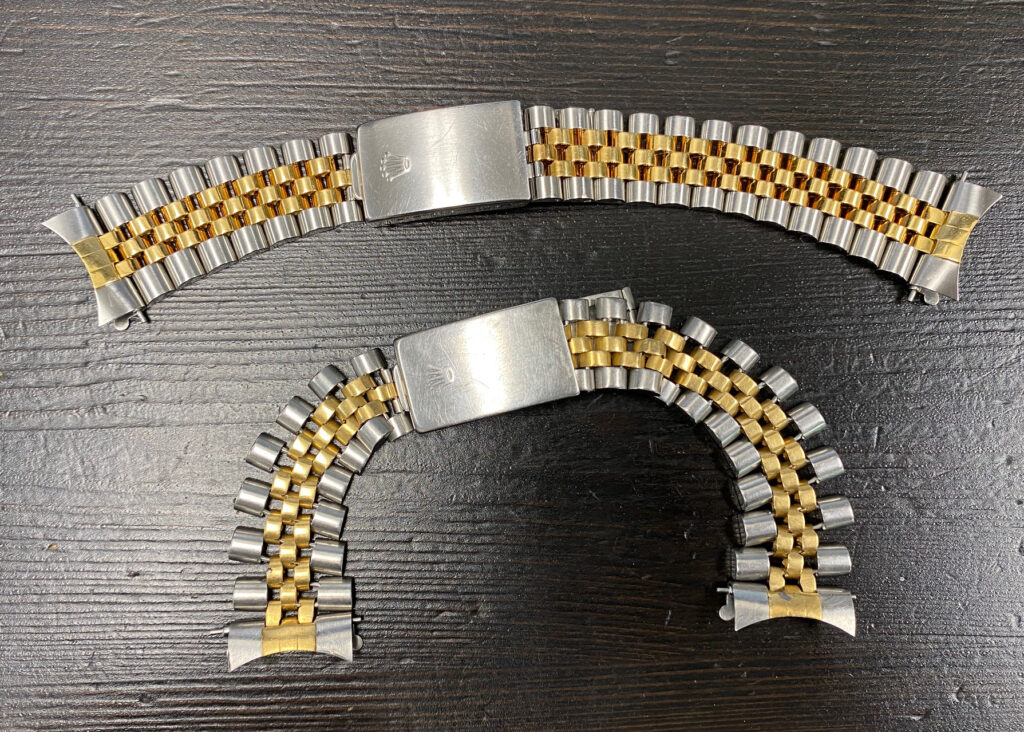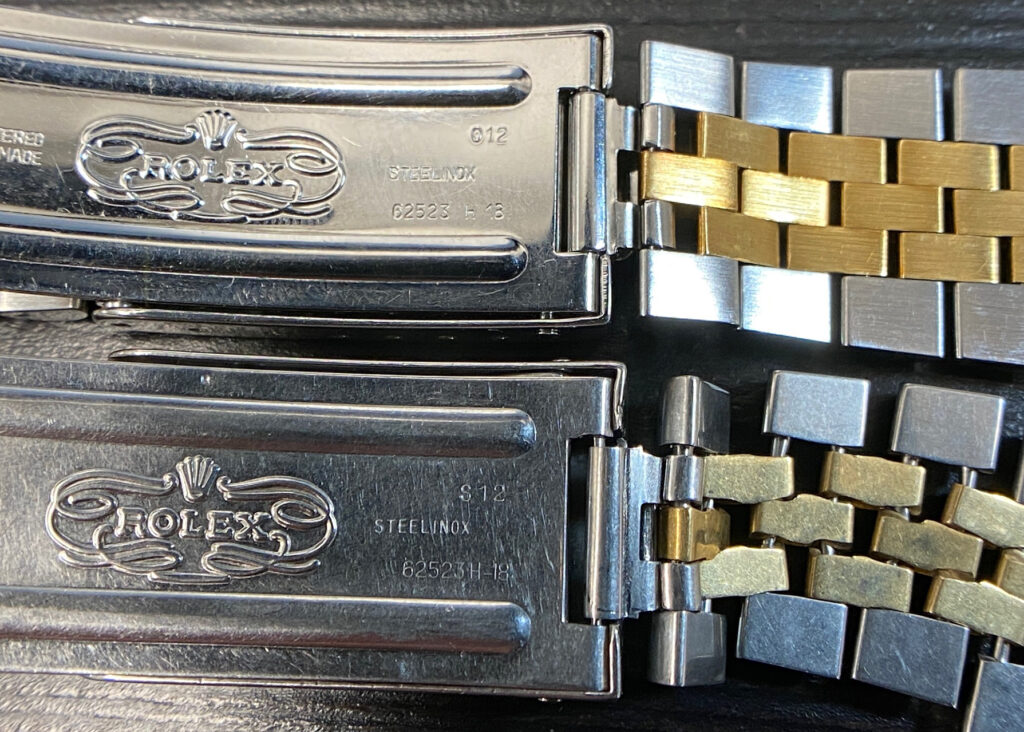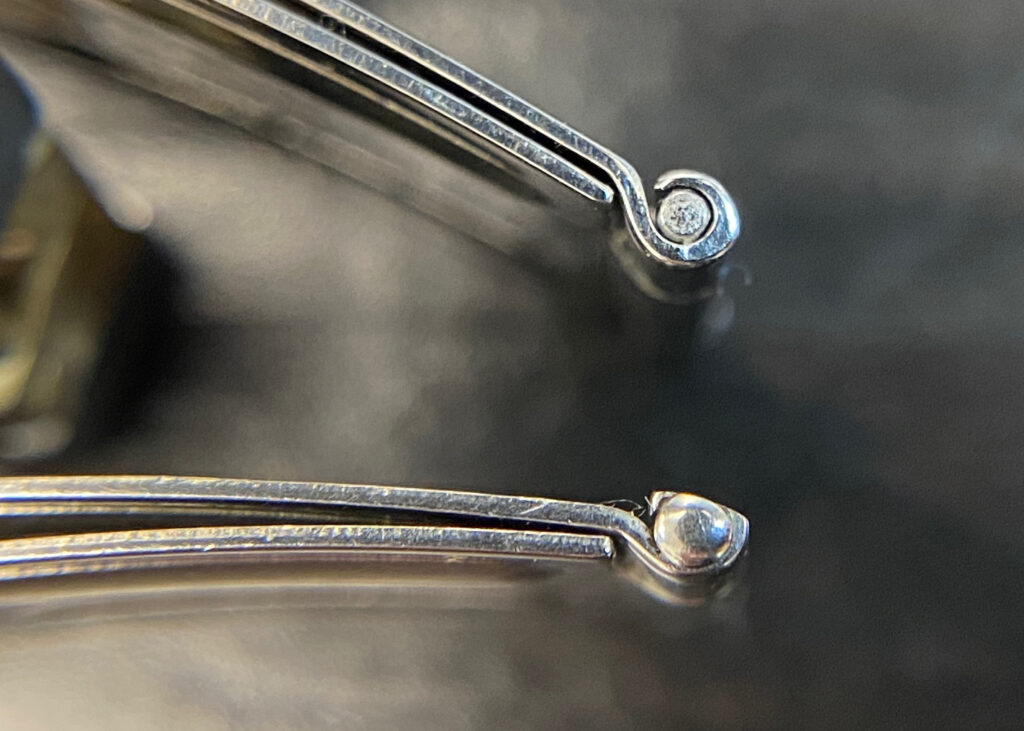
These two bracelets are identical…

Actually, from these clasp codes, you can see that bracelet in the upper portion of the photo, which was manufactured in 1990, is actually 4 years older than the bracelet in the lower portion of the photo…

So what happened here? Why does one of these bracelets look 2 years old while the other looks 100 years old? And, more importantly, what can you do about it if your bracelet looks like the lower bracelet here…

The only difference between the upper and the lower bracelet is how the wearer wore their watch. It doesn’t seem like it would make too much of a difference but wearing a watch snuggly, or loosely, on the wrist makes a huge difference in how long your Rolex bracelet will last before an intervention becomes necessary.
Yes, simply wearing your watch comfortably tight on your wrist will prevent the type of wear that has befallen the lower bracelet. A loosely worn bracelet experiences infinitely more wear day in and day out resulting from the additional space, or “play”, present between the links and their interconnecting pins.
Many women treat their Rolex watch as though it’s jewelry, preferring to wear it loose as they would any other bracelet. Men and women new to wearing a wristwatch may be unaccustomed to how it feels to have a large, heavy chuck of metal strapped securely to their wrist and may initially feel claustrophobic, opting to loosen it up a bit. Many celebrities, musicians, professional athletes, and influencers wear their watches loose, which, intentional or not, can come across as “I have so much money that I don’t need to take care of my expensive things”. You know, kind of like this…

Regardless of the reason, it’s your watch and you can and should wear it any way that you like. Just know that there are consequences.
So, now you know how to not f-up your bracelet in the first place (store that information away in the “wish I had known that before” file in your brain), but it’s too late for your existing bracelet. Your watch either doesn’t look as good as it once did on your wrist due to the stretch and wear between the links, or it’s now structurally compromised — at risk of breaking.
There are a number of companies that offer to “tighten” or “restore” your Rolex bracelet, and at prices that seem reasonable. But if you look at the photo above, you can see that the links of a Rolex bracelet aren’t designed to be taken apart. There’s a reason that Rolex doesn’t offer bracelets restoration and neither do we. The only way to “tighten” a Rolex bracelet is to break it repeatedly, to remove or drill out the pins that have heroically kept the watch secured on your wrist for decades, and to replace them with new aftermarket pins manufactured in China for less than 1¢ each.
This often results in a weaker bracelet than the stretched one you started out with.
Replacing the worn, thin, bent interconnecting pins isn’t typically enough to rid the links of the unwanted stretch. Bushings of increasingly larger diameters are added around the pin to fill in the space created on the inside of the link. As the wear is typically different from link to link, this often results in uneven spacing from link to link and we’ve seen some links link and bind after being “restored”, no longer moving fluidly on the wrist.
And none of this “tightening” has done anything to address the underlying — and more pressing — issue with your bracelet: the stretched and worn links and the risk of breaking.
Being a soft metal, the 18k gold center links of your bracelet are particularly at risk of stretching and internal wear. Center links will often look ok on the outside, but once you take the bracelet apart and view the links from the inside, some are worn paper-thin. To address this, in addition to replacing the pins, you would need to also have each of the 18k gold center links replaced. Rolex doesn’t sell these pieces so these must be replaced with aftermarket pieces. And then there’s the wear to the stainless steel portions of your bracelet fixable by laser welding or by replacing with used genuine or new aftermarket pieces.
In either instance, Rolex now considers your bracelet to be aftermarket not genuine. Dealers like us also view these restored bracelets as a negative instead of a positive, oftentimes offering less for a watch with a retired bracelet than we would have if the bracelet was all original but stretched. In other words, you’re paying hundreds of dollars to have a bracelet restoration company make your watch worth less money.
So if tightening isn’t the correct answer, what should someone do about the existing stretch in the bracelet?

Independent Rolex parts account holders like our watchmakers can order a replacement clasp as Rolex classifies clasps as “functional components”. Rolex classifies the bracelet as “jewelry”. Therefore these are not available to watchmakers. However, authorized Rolex dealers — stores that sell new Rolex watches — are able to order a replacement bracelet for you.
At the time of this posting, replacement stainless steel bracelets start at $1,250 and stainless steel / 18k gold bracelets start at $3,350. To have an authorized Rolex dealer order one for you you’ll need to prove that you possess the watch for which you’re attempting to order the bracelet and that the bracelet corresponds to your reference (i.e. they won’t sell you a Glidelock bracelet for your 2001 Submariner). The cost of a new bracelet from Rolex AD is no doubt expensive but Rolex does offer a discount for trading in your old stainless steel / 18k gold bracelet (you’d need to enquire with an AD to find out how much of a credit you’ll be extended for your particular bracelet). There isn’t currently any trade-in credit for all stainless steel bracelets.
There is another solution, however. The easiest and — in our opinion — the best solution is to simply remove a link or to adjust the clasp sizing pin down to a smaller position, on your existing bracelet. Aesthetically, when a watch is being worn, the only way to identify a stretched bracelet is by how much or little it flops around on the wrist. So by shortening the length of the bracelet, your bracelet won’t appear so worn and stretched out. This will also go a great length to stopping future wear, possibly adding years to the lifespan of your worn bracelet.
Better information makes you better informed. Check out our other Stories as well as the Rolex Repair page of our website for more info!
The Watch Buyers Group

